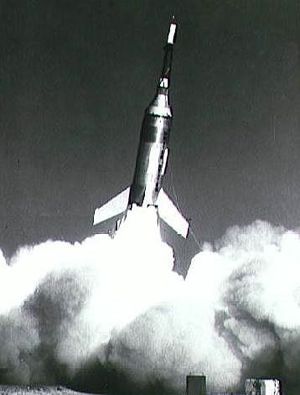
Home - Search - Browse - Alphabetic Index: 0- 1- 2- 3- 4- 5- 6- 7- 8- 9
A- B- C- D- E- F- G- H- I- J- K- L- M- N- O- P- Q- R- S- T- U- V- W- X- Y- Z
Little Joe 5A
 Little Joe/Mercury Little Joe Mercury Escape Tower Test Credit: NASA |
Launched: Late 1960. Number crew: 1 .
Little Joe was a booster lashed together by NASA Langley, consisting of four Castor I rocket motors in an aerodynamic fairing. When Project Mercury began in October 1958, the purpose of the Little Joe phase was to propel a full-scale, full-weight development version of the manned spacecraft to some of the flight conditions that would be encountered during exit from the atmosphere on an orbital mission. By April 1959, plans were made for three or four Mercury-Little Joe flights with animal passengers. NASA secretly considered a manned mission but quickly dropped the idea when the dynamic pressures involved were reviewed (the concept nevertheless emerged in the trade press in ‘Aviation Leak' – Aviation Week and Space Technology). An alternative plan to put Pigs in Space was dropped in May 1959 when it was learned that pigs could not survive on their backs for a long time. Pigs were however used in drop tests of the Mercury capsule to confirm survivability of land landings without landing bag deployment.
As described in the official NASA Project Mercury history:
Through April and May (1959), McDonnell engineers fitted a series of four Yorkshire pigs into contour couches for impact landing tests of the crushable aluminum honeycomb energy-absorption system. These supine swine sustained acceleration peaks from 38 to 58 g before minor internal injuries were noted. The "pig drop" tests were quite impressive, both to McDonnell employees who left their desks and lathes to watch them and to STG engineers who studied the documentary movies. But, still more significant, seeing the pigs get up and walk away from their forced fall and stunning impact vastly increased the confidence of the newly chosen astronauts that they could do the same. The McDonnell report on these experiments concluded, "Since neither the acceleration rates nor shock pulse amplitudes applied to the specimens resulted in permanent or disabling damage, the honeycomb energy absorption system of these experiments is considered suitable for controlling the landing shock applied to the Mercury capsule pilot."
Spacecraft: Mercury.
Back to top of page
Home - Search - Browse - Alphabetic Index: 0- 1- 2- 3- 4- 5- 6- 7- 8- 9
A- B- C- D- E- F- G- H- I- J- K- L- M- N- O- P- Q- R- S- T- U- V- W- X- Y- Z
© 1997-2019 Mark Wade - Contact
© / Conditions for Use